
Health 'Insurance' at Sea: 1 2 3 4 5 6 7 8 9 10 11 12 13 Next>>
Health 'Insurance' at Sea During the Golden Age of Piracy, Page 1
"As the Government does, and ought to expect from the Sailers the most strict Compliance
with their Duty, so are there, on the other hand, several Things which should be very carefully performed with respect to them: As... The looking well after them, when Wounded, or Sick, at Sea, and when they are put on Shore under those Circumstances. ...especially in the West Indies, is not unworthy Consideration, for certain it is, that there cannot be too much Care taken to preserve a Race of Men so absolutely necessary for the Good of our Country." (Josiah Burchett, "To the Reader", Memoirs of Transactions at Sea During the War with France, 1703, not paginated)
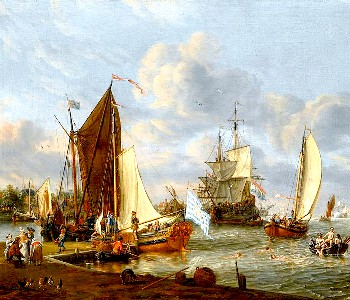
Artist: Abraham Storck - A Dutch Harbour Scene (late 17th/early 18th c.)
Although Burchett was clearly speaking of the navy, his exhortation to protect the 'absolutely necessary' men was embraced by the whole of the maritime culture. Historian Cheryl Fury points out that even the merchant ship's masters "attempted to minimize the dangers and problems of provisioning in an attempt to maintain the health of seamen: hungry, thirsty, unhealthy seamen rarely make for successful voyages."1
The British Royal Navy began creating plans to protect their sailors in the late 16th century which grew and expanded dramatically in the seventeenth and eighteenth centuries. Since many pirates had almost certainly served on naval and merchant marine ships, they adopted rudimentary health care plans in the early eighteenth century and modified them to fit their particular situation.

Artist: Gustav Dore, From Rime of the ancient mariner (1876)
Men at sea during the golden age of piracy faced a variety of challenges. The first that comes to many people's minds are wounds received in battle. The second are shipboard accidents. However, a sailor was far more likely to succumb to maladies contracted by coming in contact with unfamiliar people, places, parasites and foods. Such encounters could result in malaria, typhus, dysentery (fluxes), flus and a variety of illnesses simply diagnosed as fevers. Scurvy and syphilis also took their toll on sailors during this period. A naval expedition in 1693 "cost the country the death of upwards of a thousand officers and men by disease, while not more than a hundred and twenty had fallen by the hands of the enemy."3
Although the health initiatives of this period were simpler than those which we are familiar with, they had a number of familiar facets: provision of qualified medical professionals in the form of sea surgeons, immediate and short-term treatment programs for men who were either hurt and fell ill while at sea and long term care programs for those men irreparably maimed in the course of a voyage. We will look in detail at each of these three facets as they applied to merchant sailors, the British Navy and pirates.
1 Cheryl A. Fury, "Health and Health Care at Sea", The Social History of English Seamen, 1485-1649, p. 193; 2 Gerard Malynes, Consuetudo, ev., Lex Mercatoria: Or, The Ancient Law-Merchant in Three Parts, 1685, p. 87; 3 William Laird Clowes, The Royal Navy A History, Vol. 2, 1897, p. 471
Sea Surgeon Provision
"...for what person is, or can bee more necessary, or more usefull in any common-wealth or place, then the expert Artist, skilfull in the divine science of healing?" (John Woodall, the surgions mate, 1639, Preface, not paginated)
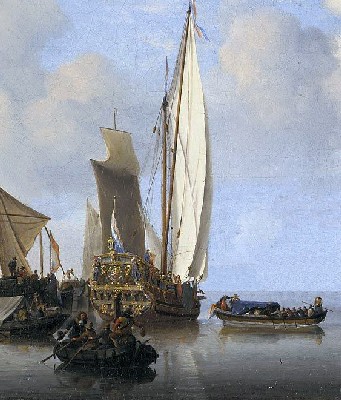
Artist: Willem van de Velde the younger
Llading Schepen op de Rede (1658)
The most basic form of insurance for a crew was the provision of a sea surgeon. Ship's surgeons were "recognised as desireable for the reassurance of the crew but also essential to maintain their numbers and fitness."1 Although the presence of a surgeon is not specifically required by Article 7 of the 12th century Laws of Oleron, they do specify that the ship's "Master is to keep his Company in Peace, and if any Mariner shall be hurt in doing service, or by his Companion, the Master shall cause him to be healed, as he who is only answerable for the fact within Shipboard, and then by his authority recover from the other Mariner the charges, and anything that the hurt man hath lost thereby; except that he who is hurt or lamed, have provoked the other by evident assault or stroaks."2
In addition to these ancient laws, historian Cheryl Fury points out that it was simply good business. Merchants looking "to profit from the expansion of trans-oceanic travel and the growth of the early modern world economy began to appreciate the close connection between profit and the health of the seamen."3 She notes that merchant ships had to work harder to attract sailors and so "were more conscientious about retaining employees [particularly because] they usually lacked the ability to compel men to serve."4 In addition, many merchant sailors had naval experience, the men would have "become more and more accustomed to having surgeons aboard."5 This suggests that, all other things being equal, a man would prefer to serve on a merchant ship with a surgeon than one without one.
Most large merchantmen would have had a surgeon on board for longer journeys such as those to the East and West Indies.6
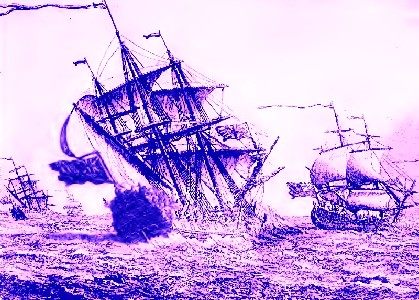
An East indiaman in 1720, From The Clipper Ship Era, by Arthur H. Clark, p. 24
The East India Company's 'lawes and standing orders' specified that their surgeon general was to hire "skilfull and honest Chirurgions [surgeons] and their Mates, at such reasonable rates of wages, as possible he may: and he shall acquaint and shew them from time to time, all such Medicines and things as shall be furnished into the Chests, of which they are to take
charge for the voyages."7 The surgeon general was also responsible for inspecting each surgeon's chests and instruments as well as checking their journals "to see how they agree upon the particulars, that errors may be avoyded."8
At the time of these directives, the company's surgeon general was none other than John Woodall, author of the first sea surgeon's surgical manual and eventual supplier of the medicine chest to the Royal Navy. He had much to say on the duties of a sea surgeon as we shall see.
Smaller merchant crews and those on shorter voyages would have been less likely to have a sea surgeon because of the extra expense. For example, the Palm Tree, a 35 foot long ship of 40 tons sailed from England to Barbados in 1699 with a 5 man crew.9 It would have been hard to justify bringing a surgeon along as a sixth crew member on such a vessel.
As a result, most sea-surgeons found on merchant ships were primarily "employed on East Indiaman..., ships with large numbers of passengers, privateers, slavers and occasionally whalers."10 Even knowing this, It is difficult to say how many of the the merchant ships would have had a surgeon because very few records from such vessels survive. Cheryl Fury suggests that English "companies made the most strides to improve the lot of Elizabethan seamen in order to attract and preserve the labour force"11, yet by "the eighteenth century, most English [merchant] mariners sailed on ships without surgeons"12.
_Francis_Hayman_mid_18th.jpg)
Artist: after Francis Hayman
Operating on a Patient (mid 18th c.)
When a merchant ship had no surgeon, the duty of healing the men fell to the officers. Historian Kevin Brown says that "the captain was responsible not only for maintaining the health of the crew but also for treating them if they fell ill or were injured."13 Other officers may have served in this capacity as well. While a first mate, Nathiel Uring explained that while they were in Angola, "our Surgeon and second Mate both died, so that the Care of the Sick and Lame fell to my Share."14
Historian Zachary Friedenburg explains that when serving as the surgeon, a ship's captain "carried a manual of directions for treating medical and surgical emergencies.”15 What this manual might be likely varied; presumably Woodall's book the surgions mate was a popular choice as was the more direct and easy-to-follow The Sea Chirurgeon by John Moyle.
A large variety of other surgical manuals were also in print throughout the golden age of piracy and may well have been used. Naval historian John Keevil suggests James Cooke's Supplementum Chirurgiae ... wherein is contained Fevers, Simple and Compound, Pestilential and not, Rickets, Small Pox and Measles, as also the Military Chest "was of particular value to sea-surgeons, whose responsibilities extended from surgery in action to the. care of seamen suffering from dysentery, typhus or the more common illnesses met with in daily life ashore."16
The British Navy was also subject to the Rules of Oleron. Being much more likely to engage in battle,

/King Charles I, after original by Anthony van Dyck (1636)
naval ships could have more urgent need for ship's surgeons, particularly during times of war. During the reign of Henry VIII, the navy was expanded and with it came sea-surgeons. "In 1513, there were thirty-two surgeons serving under four master surgeons and one chief surgeon in the Hernican navy, all of them appointed for the duration of each major campaign."17
Under King Charles I, it was directed in 1629 that "all the English ships calling at English ports to have a surgeon on board. The king ordered the Barber-Surgeons’ Company [of London] to get 97 trained Surgeons to fill the ships which had not surgeons, for when the law came into force"18. As a result, the Navy Office to the Board of Admiralty issued a letter on March 23, 1635 directing,
'The Fleet now drawing near hand ready to goe to Sea we have according to the ancient custome given orders to the Masters and Wardens of Barber Chirurgeons' Hall, to press [force into service] Chyrurgeons for all the Ships of the first Fleet and have given them charge to cause them to appeare before us att the Meeting house in Mincing Lane, on fryday in the afternoon the 1st of Aprill, for the Vice Admirall and Rere Admirall to be satisfied of their Sufficiency19
From this time, all British naval vessels should have had a surgeon along with assistants or surgeon's mates. The number of mates the surgeon had on a ship depended on the size of the vessel. In 1691, for example, a first rate ship had 5 surgeon's mates, with the number of mates assigned decreasing by 1 for each decrease in the ship's rate so that a second rate ship had 4 surgeon's mates, a third had 3 and so on.20 Although the Royal Navy started employing sea surgeons later in history than commercial vessels, they were almost certainly better outfitted with them than either the merchant or pirate ships.
1 Jessie Dobson & Robert Milnes Walker, Barbers and Barber-Surgeons of London, p. 47; 2 Gerard Malynes, Consuetudo, ev., Lex Mercatoria: Or, The Ancient Law-Merchant in Three Parts, 1685, p. 103; 3,4 Cheryl A. Fury, "Health and Health Care at Sea", The Social History of English Seamen, 1485-1649, p. 193; 5 Fury, p. 219; 6 Zachary B. Friedenberg, Medicine Under Sail, p. 25; 7 East India Company, The lawes or standing orders of the East India Company, 1621, p. 34; 8 East India Company, p. 35; 9 Ian K. Steele, The English Atlantic, 1675-1740: An Exploration of Communication and Community, 1986, p. 3; 10 Peter Earle, Sailors - English Merchant Seamen 1650-1775, 1998, p. 138; 11 Fury, p. 193; 12 Earle, p. 138; 13 Kevin Brown, Poxed and Scurvied: The Story of Sickness and Health at Sea, p. 139; 14 Nathaniel Uring, A history of the voyages and travels of Capt. Nathaniel Uring, p. 47; 14 Friedenberg, p. 25; 16 John J. Keevil, Medicine and the Navy 1200-1900: Volume II – 1640-1714, p. 31; 17 Brown, p. 23; 18,19 Dobson & Walker, p. 48; 20 Keevil, p. 281
Pirates 'Recruiting', Forcing and Taking Surgeons
Pirates were at the greatest disadvantage when it came to 'employing' sea surgeons for their vessels - they wanted sea surgeons, but most sea surgeons didn't want them. (There are some notable exceptions to this - George Wilson and Peter Scudamore both willingly joined Bartholomew Roberts' pirate fleet.) Unfortunately for pirates, their need for sea surgeons was no less urgent than that of the navy
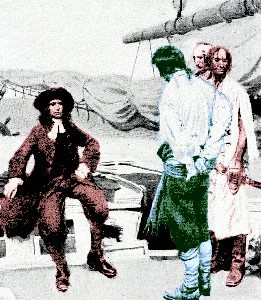
Artist: Howard Pyle (1901)
and may even have been greater during the latter part of the golden age of piracy when England was at peace. Since the surgeons weren't usually interested in the pirates, they did what came naturally; they stole them.
After pirate captain William Fly had taken several prize ships, he "forced on board [of his ship] carpenters, caulkers, armourers, surgeons, and musicians."1 In June of 1718, surgeon's mate Richard Moor was "was forced by the s[ai]d Pirates [pirate captains Olivier Levasseur and Jeremiah Cocklin] on board and into the Service of ye s[ai]d Ship the Speedwell [Cocklyn's ship]"2.
Upon taking the merchant ship Don Carlos on October 21, 1721, John Gow's "Pyrates killed 2 of her Men and took away the Surgeon; and five Sailors entered themselves voluntarily."3 It is notable that the surgeon was the only man forced away from his vessel in this particular encounter. In a more broadsweeping capture, Edward Low "took three Men and the Surgeon out of the [merchant ship] Forward" when he captured it, the Merry Christmas and the Baily in 1723.4 While certain men with desired skills were often forced to join pirates such as the surgeon and carpenter, undermanned pirate vessels also took regular sailors to increase their manpower and make them look more imposing during attacks.
Captain Chaloner Ogle, who defeated pirate Bartholomew Roberts' three ships in February of 1721, noted that Robert's crew had recently taken Thomas Hill's pink Neptune off Cape Lopez [in what is today Gabon, Africa] and "robb’d him of... his Surgeon and four Men".5 Two of Roger's other pirate surgeons, Adam Comrie - taken from the merchant Elizabeth in January of 1721 - and William Child - taken in October of 1720 from the Mercy Galley, were cleared of all charges during the trial that followed Ogle's capture because the court believed them to be forced men. During the trial, Child explained that he had no reason to join the pirates of his own free will because he had "a good Employ whereon to build, and Friends to advance him in the World in an honest and reputable way of Livelyhood."6
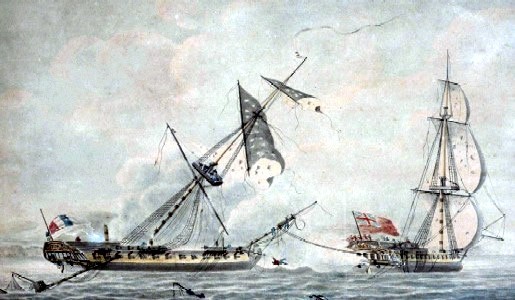
Artist: Robert Dodd - HMS Blanche Towing Captured Ship in 1795 (1800s)
Perhaps the most graphic account of the pirate's method for employing surgeons is described by captured slave ship captain William Snelgrave. He nearly lost his ship's surgeon James Bleau when his ship was taken by pirates Levasseur, Cocklyn, and Howell Davis in 1719. According to Snelgrave, the pirates intended "to take [his surgeon] by force with them. This honest Man and been very much cast down at it, and had often desired me to intercede for his liberty. Accordingly I had done it, representing, 'That he grieved himself so much, that if he did not die quickly, yet he would be of no use to them:' But this had no effect."7 At the last minute, the pirates decided instead to press the captain of a French vessel taken shortly before Snelgrave's into service, "whereupon they gave Mr. Bleau his Liberty the next morning."8 So while these pirates wanted surgeons, they were at least not greedy.
1 Captain Charles Johnson, The History of the Pirates, 1829, p. 145; 2 "The Examination of Richard Moor, 31 October, 1724. HCA 1/55, ff. 94-97", Pirates in Their Own Words, Ed Fox,, ed, p. 208; 3 London Journal, 12-9-21, Issue CXXIV; 4 London Journal, 8-10-23, Issue CCXI; 5 Post Boy, 8-4-22 - 8-6, Issue 5168; 6 Pyrates Lately taken by Captain OGLE, 1723, p. 33; 7,8 William Snelgrave, A New Account of Some Parts of Guinea and the Slave Trade, p. 279

